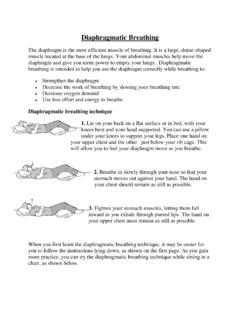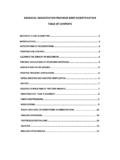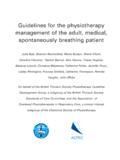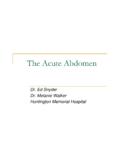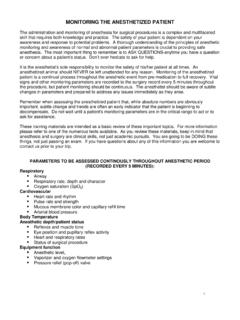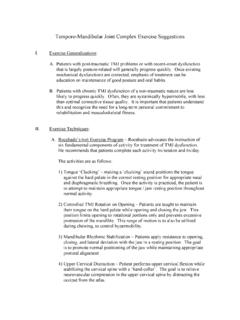Transcription of Introduction The Inner Core Muscles
1 Introduction Pilates focuses on the deep postural Muscles , including the pelvic floor, the transversus abdominis (TA) and the multifidus. These deep postural Muscles are also referred to as the core . Improving core muscle control, coordination, flexibility and strength will create a balance within the body. Combined with developing proper techniques, the body will learn to move in a safer, more efficient pattern of motion. The benefits of a body trained for core strength and flexibility are many. It provides an optimal foundation for sports training and performance, good posture and overall well-being.
2 The Inner core Muscles The Inner core refers to a group of deep Muscles in the trunk that, under normal circumstances, work together to provide the first step in stabilization of the trunk and pelvis. In the moving body stability refers to precise joint control through motion. The Inner core Muscles playa key role in stability of the trunk and pelvis. In normal function these muscle are programmed to contract automatically and simultaneously before any - movement or other muscle contraction. We use these Muscles at about 20 to 30% of maximum to create stiffness of the lower spine not rigidity.
3 The Inner core group of Muscles are: The diaphragm - your primary breathing muscle attached to the lower ribs and spine; The pelvic floor - attached to the bony ring of the pelvis from the tailbone to the pubic bone and side. to side between the 'sit bones'. The lumbar multifidus - deep in the low back. The transverse abdominis - the deepest layer of the abdominal Muscles . Why Train The Inner core ? There are several reasons to train the Inner core Muscles : Ensure a normal muscle strategy for stabilization of the back during functional activities. Prevent injury.
4 Enhance athletic performance. Restore normal muscle function lost due to injury. How Do You Train The Inner core ? It is important to know how to appropriately contract (tighten) the Inner core Muscles before you begin a program to improve strength and trunk stability. The following pages go over each of the Muscles individually and ways to specifically contract each one. The Diaphragm The diaphragm is a dome shaped muscle that forms the roof of the Inner core and is located at the base of the ribs. It is your primary breathing muscle. During higher-level activity, including running and sports activities there are additional Muscles attached to the rib and neck areas that assist the diaphragm for deeper breathing capability, increasing the amount of air going into the lungs.
5 The diaphram actually attaches to the spine and has a mechanical influence on spinal stability. It is important to be able to contract the other Inner core Muscles while breathing with the diaphragm. We often call diaphragmatic breathing "belly" breathing because the abdomen distends somewhat as the lungs fill with air. As the diaphragm contracts it is pulled downward. This pushes on the organs in the abdominal area causing the abdomen to distend. The focus of diaphragmatic breathing should not be just on the 'belly' distending but also on lower rib movement: outward in all directions (forward, lateral and backward).
6 We train the diaphragm with the rest of the Inner core by breathing correctly. We. are not talking about deep breathing or shallow breathing . The goal is to breath using the diaphragm to expand the lower ribs in all directions at a depth and rate of respiration that matches the activity. Exercise #1: Lie on your back. Place your hands on your lower ribs with the heels of your hands at your sides and the fingers towards the front. Observe the movement of the ribs during 'quiet breathing '. If you do not feel movement both forward and to the sides then try to make this movement happen without changing the depth of your breath.
7 You can also practice this breathing exercise in sitting or standing several times a day. The Pelvic Floor The pelvic floor (PF) Muscles make up the floor of the Inner core . There are two layers of Muscles which attach to the bony ring of the pelvis. Think of the outer / lower layer as extending between the 'sit bones' and the Inner / upper layer as extending from the tailbone in back to the pubic bone in front. In addition to other functions the PF Muscles help to support (hold up) the organs in the pelvic region including your bowel and bladder.
8 Finding Your Pelvic Floor Muscles : Exercise #2-A Cues to think about to get the right muscle contraction: To contract the outer / lower layer of the PF think of 'closing the openings' or bringing the 'sit bones' toward each other. To contract the Inner / upper layer think of 'lifting' or bringing the tailbone toward the pubic bone. Use these cues in the exercises below. Exercise #2-B (to be done just a few times at most) To see if you are using the right Muscles : the next time or two that you need to urinate empty about half the volume of your bladder then stop the flow of urine with the least amount of muscle effort possible.
9 Be aware of which muscle you are using. Try to hold this muscle contraction for 10 seconds. Then let a little more urine out and try holding again with the least amount of effort possible. This IS NOT to be used as a daily exercise. It is only a way for you to identify where your PF Muscles are. Exercise #2-C Sit on a chair or on the floor. Use your hands to feel each of the bones you are sitting on. Remove your hands but remain aware of your "sit bones" being in contact with the chair or the floor. Contract the PF Muscles as noted in #2-A. You should feel a pressure change against the chair seat / floor.
10 Try to hold this contraction for ten seconds while you breath normally. Then relax and feel the PF Muscles relax with respect to the chair floor. Exercise #2-D The Elevator: 'Close the openings' then lift up the 'elevator' one floor, then a second floor, etc. Go up then down floors, one floor at a time. The Transverse Abdominis The transverse abdominis (TA) muscle is the front wall of the Inner core . It is the deepest layer of the abdominal Muscles and the fibers of the muscle run horizontally across the abdomen. When this muscle contracts the abdomen pulls inward.
